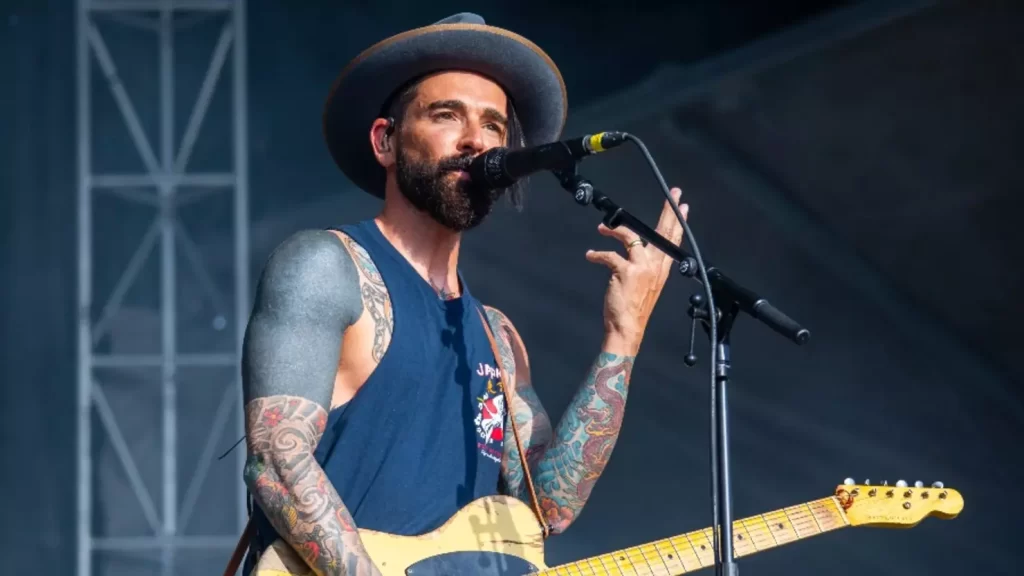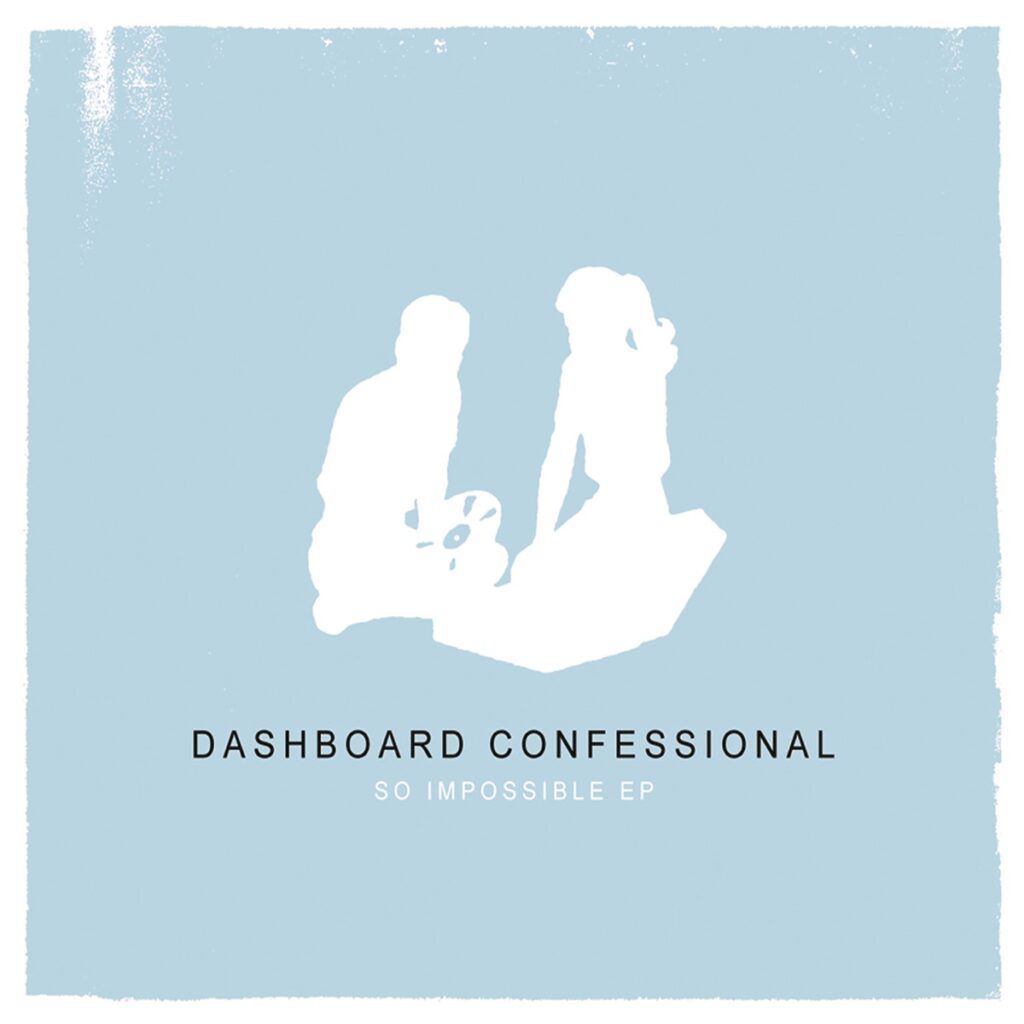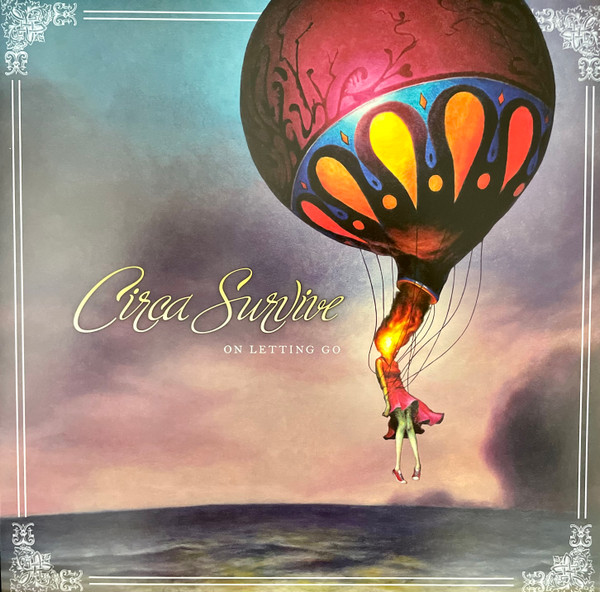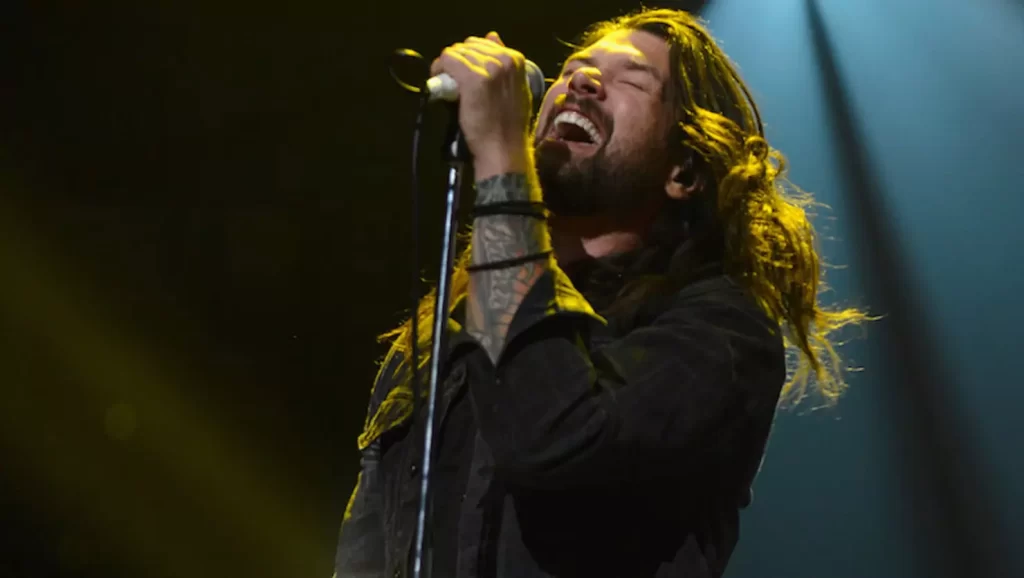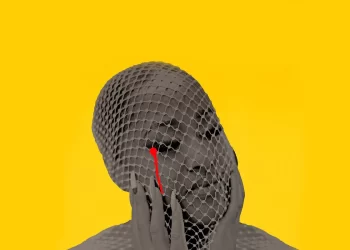By Keith Richards
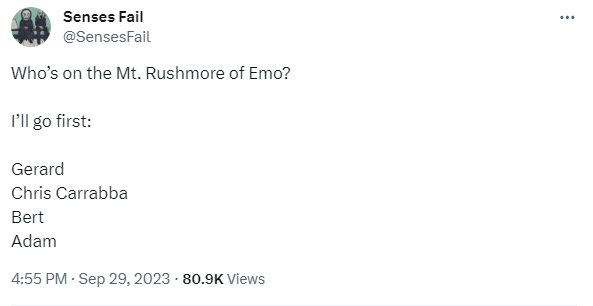
“Emo is not a phase. It’s a lifestyle.” That’s the motto I’ve lived by since I was a teenager. Emo music has defined and shaped my life for 20 years now. Recently, thanks to a Senses Fail Twitter post, I began to wonder, “Who are the four artists on the Emo Mt. Rushmore?”
It’s a pretty loaded question. Emo music, though similar in subject, is vast in style and approach. Choosing an Emo Mt. Rushmore is both not easy and highly subjective. Who makes my Emo Mt. Rushmore may not make someone else’s. Still, I present to you the Emo Mt. Rushmore of lifetime Emo kid, Keith Richards.
What is Emo Music?
To understand why the upcoming individuals are on the Emo Mt. Rushmore, we must first go back to the origins of emo. You can trace the roots of emo back to Washington DC and the mid-1980s. Back then, bands like Rites of Spring and Embrace pioneered the original emo movement. Initially, emo was known as emotional hardcore or emocore. With the help of other genres of rock, it would continue to evolve in the mid-1990s.
In the mid-1990s, the emo movement began to spread West. Bands like Sunny Day Real Estate and the Get Up Kids (Midwest) would expand the boundaries of emo music and help to spawn subgenres of emo music. These subgenres that emerged in the 2000s would help emo music reach its pinnacle in a time that I call “The Golden Era of Emo.”
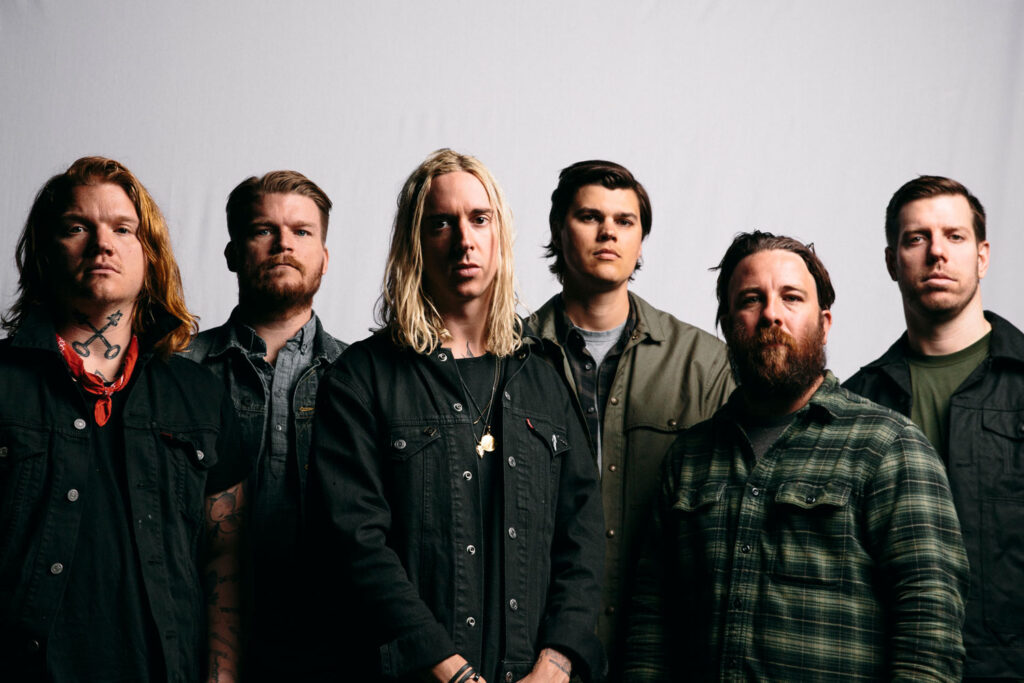
In the 2000s, the emo genre spawned the subgenres of screamo and emo pop. Bands like Dashboard Confessional, Fallout Boy, and Underoath achieved mainstream success unlike anything else in emo to that point. With their eyeliner, studded belts, and long bangs, emo kids embraced the emo lifestyle and never looked back.
In fact, all of the members of my Emo Mt. Rushmore hail from the Golden Era of Emo. These four individuals are what I see as the personification of emo. Again, this is completely subjective. My Emo Mt. Rushmore may differ drastically from someone else’s Emo Mt. Rushmore. Then again, that’s the beauty of emo music. So, without further ado, I present to you my Emo Mt. Rushmore.
Jesse Lacey – Brand New – New York
Fix me to a chain around your neck and wear me like a nickel
Even new wine served in old skins cheapens the taste
I shot the pilot, now I’m begging you to fly this for me
I’m here for you to use, broken and bruised
Do you understand?
Officially formed in the late 1990s, Brand New would see prominence in the 2000s thanks to their frontman, Jesse Lacey. If there is a black sheep on the Emo Mt. Rushmore, it’s Jesse Lacey. Jesse was actually a founding member of emo legends Taking Back Sunday. Lacey would leave the band before its major release due to John Nolan sleeping with Jesse’s girlfriend. It would spawn, arguably, the best beef in emo history.
From the band’s popularity in 2000 to its disbandment in 2017, Lacey was always seen as a private individual. His seclusion only deepened following accusations against him of sexual misconduct in the early 2000s. Jesse did apologize on the band’s Facebook page but has been private since then.
To this day, Jesse has no social media accounts and he rarely gave interviews in Brand New’s prime. That, though, is what maybe puts Jesse Lacey on my Emo Mt. Rushmore. Without condemning, or condoning, Lacey had demons that he battled. He used emo music as his outlet to eloquently voice his struggles. In many ways, the Devil and God were raging inside Jesse.
Through songs like The No Seatbelt Song (Your Favorite Weapon), Play Crack The Sky (Deja Entendu), and Degausser (The Devil and God are Raging Inside Me), Lacey put his pain and his demons on display for all to see. Many, like myself, would be drawn to Jesse because he, like all on the Emo Mt. Rushmore, helped you to identify feelings you didn’t know you had.
Again, without condemning, or condoning, Jesse Lacey is a complicated individual. All of his faults and complications led to beautiful music. Music that many emo bands aspire to. That’s what puts Jesse Lacey on my Emo Mt. Rushmore.
Chris Carrabba – Dashboard Confessional – Florida
I am fairly agile
I can bend and not break
Or I can break and take it with a smile
And I am so resilient
I recover quickly
I’ll convince you soon that I’m Fine
It would be a bold proclamation to say that one artist is the personification of emo. If there is one artist on the Emo Mt. Rushmore you can make that claim with, it’s Chris Carrabba. When you think of emo music, many in emo culture would associate it with Christopher Ender Carrabba. Again, it sounds outlandish, but that’s the impact Carrabba had on the budding emo culture in the year 2000.
Born in Connecticut, Dashboard Confessional came to be in Florida. At the time, Chris was in a band named Further Seems Forever. Dashboard Confessional was a solo side project that Carrabba never thought would become emo royalty. Further Seems Forever is not well known, but Dashboard Confessional and Chris Carrabba are.
Carrabba recorded his first solo album, The Swiss Army Romance, while still with Further Seems Forever. However, before the band released its debut album, Chris left to band to record and release his second solo project; The Places You Have Come to Fear the Most. Shortly after that, Carrabba released the So Impossible EP. With just those three albums, Chris Carrabba cemented his legacy and his spot on Emo Mt. Rushmore.
What makes Chris Carrabba so special is that he was Dashboard Confessional. I don’t mean that from the standpoint of his importance to the band. Legitimately, Dashboard Confessional was Chris Carrabba. The band would not add other members until 2002, which is also the year Dashboard’s legend grew when invited to perform on MTV Unplugged.
Often, what makes the work of an artist so great is their ability to use symbolism to express their feelings. In my opinion, that’s not Carrabba. Through pieces like The Sharp Hint of New Tears, Bend Not Break, and Screaming Infidelities, Chris is very direct in his feelings and his pain, which makes him so relatable to youth like myself in emo culture. Not to be forgotten, Carrabba is also an amazing storyteller, which we saw on the So Impossible EP.
What teenage boy or girl cannot relate to the masterpiece that is So Impossible? A boy wants his crush to acknowledge him (For You to Notice). He then discovers that she also dreams of things So Impossible and invites him to a party. Getting ready for his big date, the boy has to Remember to Breathe; everything will be okay. Finally, Hands Down, it was the best day he could ever remember.
No, it’s not possible to have an Emo Mt. Rushmore without Christopher Ender Carrabba. Though he does not own the emo sound and culture, Carrabba is a cornerstone of them. Chris will forever be linked to emo.
Anthony Green – Circa Survive – Pennsylvania
Motion gives up on you in the end.
I’ll try my best to be home by then.
You’ll see the grace we had,
She’ll never have,
You’ll never have.
I’m going home but my own way.
If Jesse Lacey is the black sheep of Emo Mt. Rushmore, Anthony Green is the unicorn. If Chris Carrabba is the king of being direct, Anthony Green is the god of symbolism on Emo Mt. Rushmore. There is no one quite like Anthony Green in emo culture.

While Green is most known for his work with Circa Survive, his claim to emo royalty started in 2003 with the band Saosin. Anthony would quit Saosin after their EP, Translating the name, but would reunite with them over a decade. In just five songs, Anthony Green would show us all why he would one day be on the Emo Mt. Rushmore.
If his career had ended just there, he’d still have a strong claim to being on Emo Mt. Rushmore, but it didn’t end there. After leaving Saosin, Green would form the band that has shaped my life more than any other band has: Circa Survive.
What makes Circa Survive and Anthony Green so unique is their sound. When you listen to a track like Imaginary Enemy, it doesn’t quite feel like emo music. You get strong tones of progressive rock and post-hardcore. If you were to just listen to the instrumental, you would not think that this music came from a band that falls in the emo culture.

It’s the combination of the music by Colin, Brendan, and Steve and Anthony’s lyrics that makes Circa Survive so special. Just as you would not think Circa is within emo culture by just hearing the instrumental, you would not think of them as a progressive rock band based solely on the lyrics of their songs.
Match like Lacey and Carrabba, Anthony Green expresses his pain and torment through his music. Green’s pain and torment are the same that millions suffer from every day: Addiction. In 2014, Anthony became sober, but relapsed in 2019.
Addressing the impact addiction had on his music on Twitter, Green stated, “[Too] many songs about drugs. When I think about the impact my [addictions] have had on my life, it’s astounding.” Regarding why he turned to drugs in the first place, Anthony said, “I always felt really uncomfortable in my own skin. Like, I didn’t belong anywhere and didn’t like myself and I think drugs just made me feel good in a way that was almost a shortcut to self acceptance, except it wasn’t real and only made things worse.”
Anthony Green eloquently explains that feeling in songs like The Difference Between Poison And Medicine Is In The Dose. In that song, Green states:
Well don’t call me by my full name,
And all this is temporary.
It feels much better to know that you won’t feel a thing.
Well don’t talk about it;
Write it down but don’t ask for help.
I can’t be honest with even myself.
Did you ever wish you were somebody else?
“Did you ever wish you were somebody else?” That’s a question I’ve asked myself for years. Like Anthony, and I’m sure millions of others, I’ve never felt comfortable in my skin. Though he says, “Don’t ask for help,” it is the words of Green that gave me the strength to seek help. I believe I can safely say he’s done the same for many others.
Even without the nostalgia, Anthony Green would still make my Emo Mt. Rushmore. However, I got a chance to meet Anthony in person a few years ago at a Circa Survive show. For one thing, he knew my name, which made me almost faint. More importantly, I let him know how much his music has meant to me. The comforting hug he gave afterward will forever keep Anthony Green on my Emo Mt. Rushmore.
Adam Lazzara – Taking Back Sunday – New York
So, we’re talking forever, and you
Almost feel better, but
Better’s no excuse for tonight
You see, it’s never bad enough to just
Leave or give up but it’s
Never good enough to feel right
Remember how I said Jesse Lacey left Taking Back Sunday? Adam Lazzara was the man who replaced Lacey and Taking Back Sunday has been an emo legend ever since. Considering the well-publicized beef between the two bands, it’s ironic that Taking Back Sunday and Brand New are so alike.
While the two bands are eternally tied together, Lazzara’s uniqueness is what definitively sets the two bands apart. Adam’s presence and persona on stage are infectious. Never has anyone been able to make swinging a microphone an art form like Lazzara has. It sounds silly, but it’s hard to understand unless you’ve experienced it live.
While Taking Back Sunday has become more of a pop-punk band over the years, the band’s foundation will always be emo, which is ironic. It’s ironic because Adam has continuously stated that the band is not emo. All of emo culture may claim Taking Back Sunday, but Lazarra does not identify as emo.
In 2016, Adam said, “I’ve never considered us an emo band. I understand it’s a lot of the scene we came from. But I consider us a rock and roll band. Loud guitars, big drums. It gets frustrating sometimes because then it’s putting it in this little box that can be contained and I think we’re more than that.” Ironically, that’s kind of what emo is all about. Emo culture is all about not fitting anywhere else. So, while we unintentionally put ourselves into a box, it’s our box.
When Lazzara says, “I understand it’s a lot of the scene we came from,” he means tracks from their first two albums like You’re So Last Summer. In that song, Adam states:
I’d never lie to you, unless I had to
I’ll do what I got to
Unless I had to
I’ll do what I got to
The truth is you could slit my throat
And with my one last gasping breath
I’d apologize for bleeding on your shirt
As I said, though, no doubt Taking Back Sunday has evolved. They’re not as emo as they used to be. Still, the band’s lyrics and feel can be drippingly emo. On their 2011 self-titled album, Call Me In The Morning is the perfect example of that. In that track, they state:
I don’t know where we’re going
But I know where we’ve been
We’ve been hiding from each other
We’ve been hiding from our sins
That’s what puts Adam Lazzara on the Emo Mt. Rushmore for me. What Taking Back Sunday will be globally known for may change in the end. However, I know where they’ve come from. Lazzara may want to hide from their emo roots, but, to many, they will always be a big part of emo culture.
So, there you have it, my Emo Mt. Rushmore. What’s your Emo Mt. Rushmore? How much does it differ from mine? Let us know! There are so many others worthy of being on Emo Mt. Rushmore, it’s almost like I could write about the second tier…


 NFL
NFL


